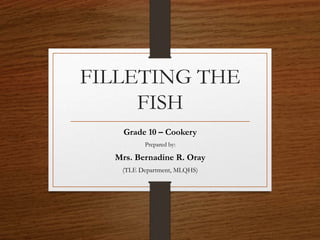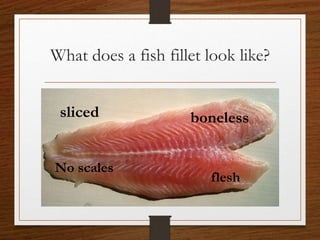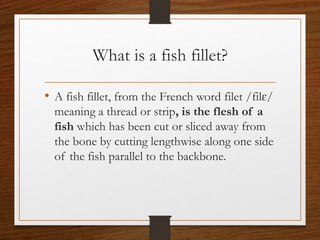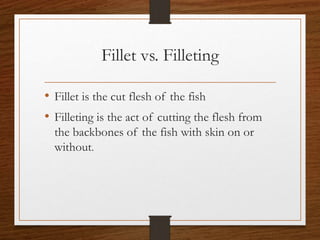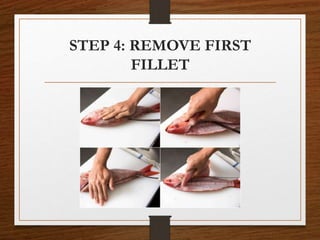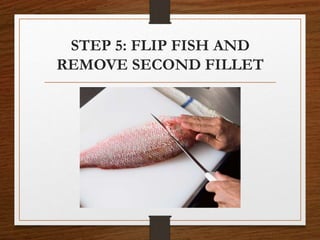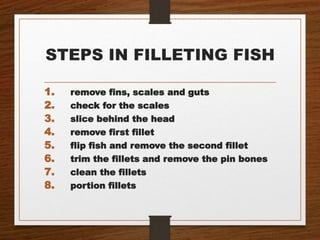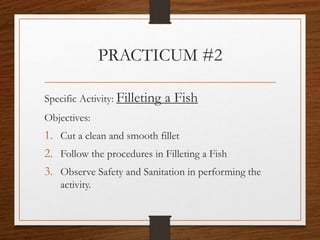Filleting the Fish
- 1. FILLETING THE FISH Grade 10 â Cookery Prepared by: Mrs. Bernadine R. Oray (TLE Department, MLQHS)
- 2. TONGUE TWISTER CHALLENGE Fresh fish fillet, Fish Fillet Fried, Fried Fish Fillet, Fillet Fish Fresh.
- 3. What does a fish fillet look like? bonelesssliced No scales flesh
- 4. What is a fish fillet? âĒ A fish fillet, from the French word filet /filÉ/ meaning a thread or strip, is the flesh of a fish which has been cut or sliced away from the bone by cutting lengthwise along one side of the fish parallel to the backbone.
- 5. Fillet vs. Filleting âĒ Fillet is the cut flesh of the fish âĒ Filleting is the act of cutting the flesh from the backbones of the fish with skin on or without.
- 8. STEP 1: REMOVE FINS, SCALES AND GUTS
- 9. STEP 2: CHECK FOR THE SCALES
- 10. STEP 3: SLICE BEHIND THE HEAD
- 11. STEP 4: REMOVE FIRST FILLET
- 12. STEP 5: FLIP FISH AND REMOVE SECOND FILLET
- 13. STEP 6: TRIM THE FILLETS, AND REMOVE PIN BONES
- 14. STEP 7: CLEAN THE FILLETS
- 15. STEP 8: PORTION FILLETS
- 17. STEPS IN FILLETING FISH 1. remove fins, scales and guts 2. check for the scales 3. slice behind the head 4. remove first fillet 5. flip fish and remove the second fillet 6. trim the fillets and remove the pin bones 7. clean the fillets 8. portion fillets
- 18. PRACTICUM #2 Specific Activity: Filleting a Fish Objectives: 1. Cut a clean and smooth fillet 2. Follow the procedures in Filleting a Fish 3. Observe Safety and Sanitation in performing the activity.
- 19. GROUP ACTIVITY Each group will choose one representative who will perform the filleting of a fish for five minutes. A rubric will be used for evaluation of the activity.
- 20. RUBRIC FOR EVALUATION CRITERIA 5 4 3 2 Accuracy All steps have been correctly followed 2 steps have been missed 4 steps have been missed No correct steps have been followed Workman- ship flesh of the fillet is intact and boneless flesh has few torn parts and boneless Flesh has some parts torn and few bones still visible flesh is totally torn and lots of bones is still visible
- 21. Proper hand- ling of tools All tools have been properly manipu- lated One of the tools is not correctly used 2-3 tools have not been properly used No tools have been used properly Speed Finished right on time The activity exceeds 1 minute to perform The activity exceeds 2 minutes to perform The activity took more than 10 minutes to perform
- 22. Safety and Sanita- tion No injury and accident happened during the activity Few/ Minor injury happened during the activity Some accidents or injuries happened during the activity Failed to observe safety and sanitation during activity Docu- menta- tion practicum sheet was completely accomplish ed and submitted on time practicum sheet has few missing parts and submitted on time practicum sheet was partially accomplish ed and submitted the day after practicum sheet has little inputs and submitted 2-3 days after the activity
- 23. ASSIGNMENT âĒ What is shellfish? âĒ How do we prepare clams, oysters and mussels?
- 24. END THANK YOU FOR LISTENING AND COOPERATING! ï
Editor's Notes
- #6: Show to the class the demo table. Ask what do they see?
- #9: If you have a whole fish that hasn't been cleaned up at all, the first step is to snip off all the fins with kitchen shears, scale the fish, and then slice open the belly and pull out all the guts. Then grab the gills (they're easy to get once you've sliced open the belly from below) and rip them all out.
- #24: Distribute the Practicum Sheet. Discuss the tools and ingredients to bring.

